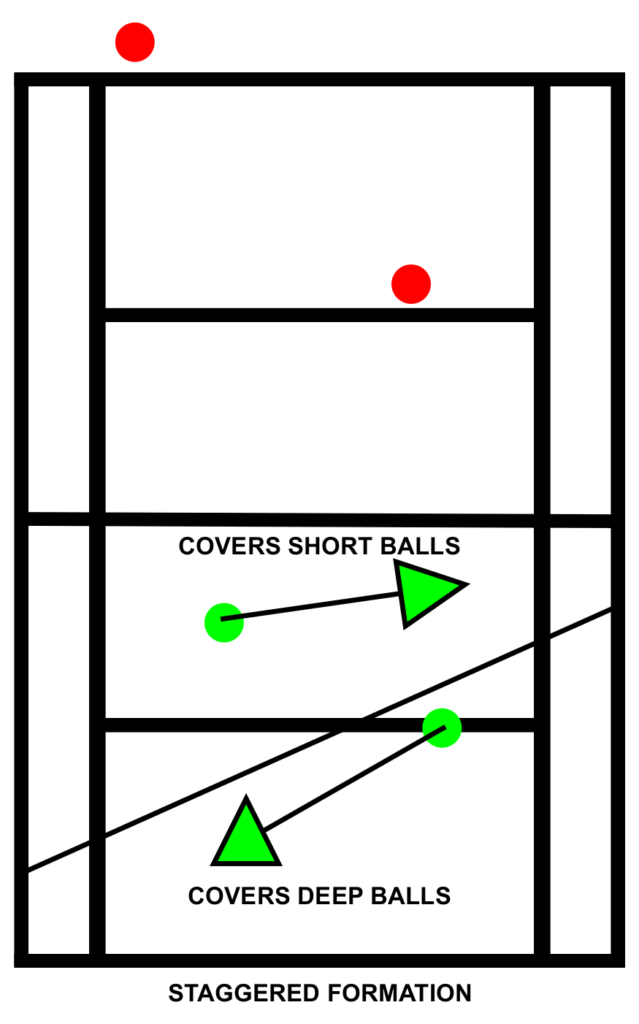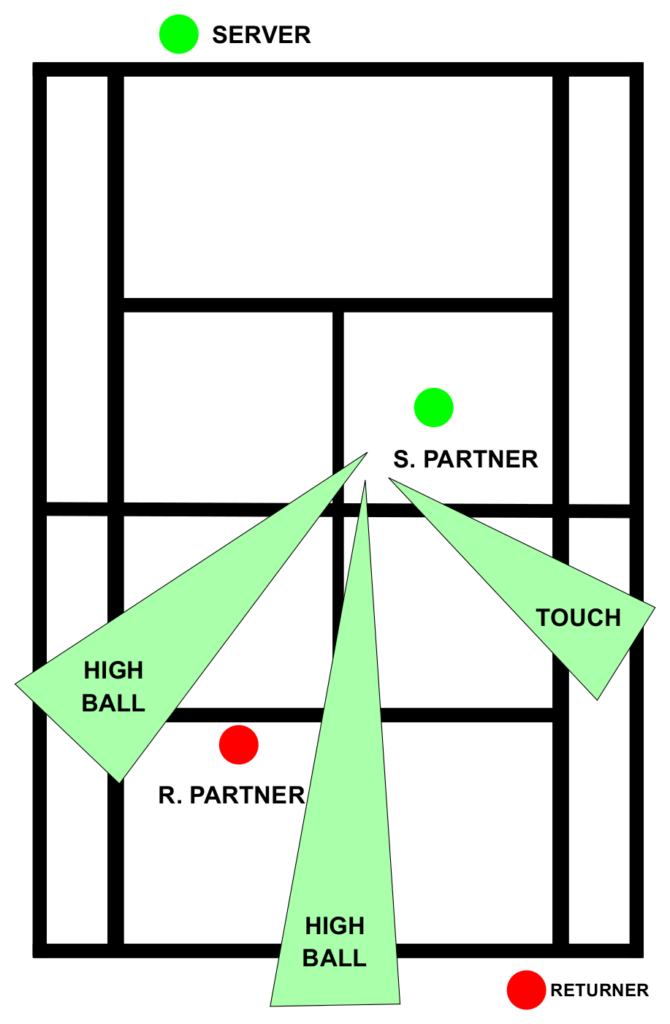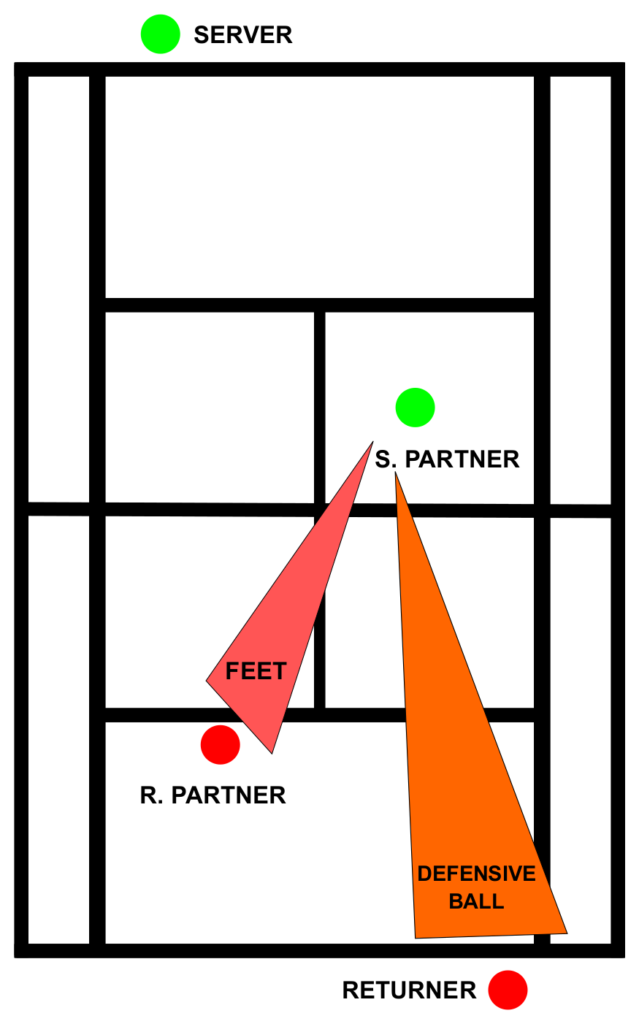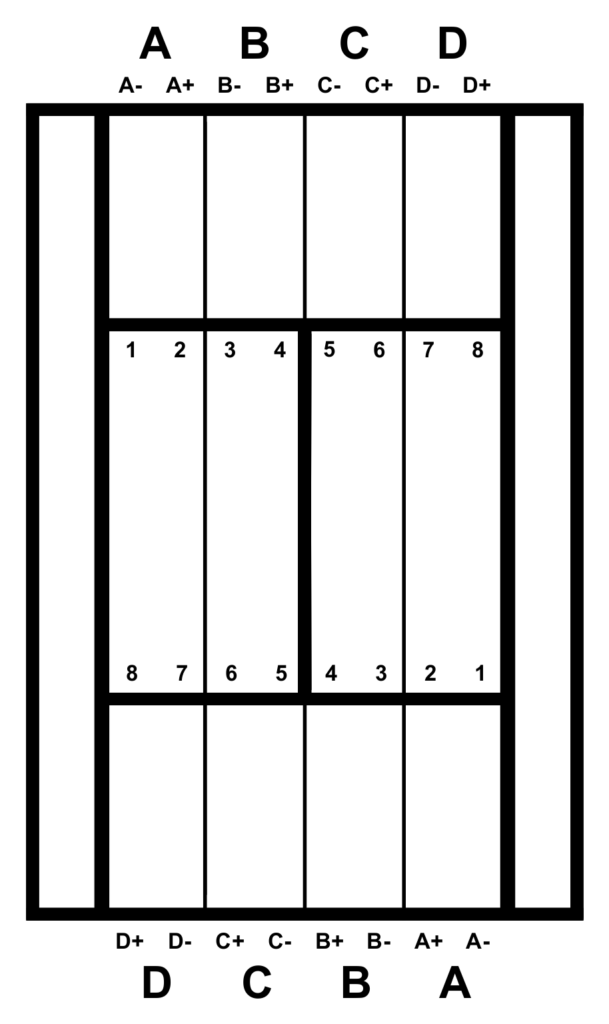Introduction
Playing tennis with different doubles partners can be frustrating because not everyone knows tennis doubles strategy. Often times tennis doubles positioning varies from partner to partner. So, rather than going off of my years of tennis experience and discussions with professionals in the industry I decided to research for statistics to determine patterns of winning doubles. After searching through resources, I came across a talk at the USPTA by Craig O’Shannessy who was formerly on the strategy team for Novak Djokovic, and is known for utilizing data to guide tennis doubles strategy and positioning.
The following article on tennis doubles strategy and positioning was created to help my tennis pros improve their teaching and our clients improve their games. Hopefully you find some value in it as well.
You will find a tennis court template that is labeled with numbers and letters at the end of the article. Refer to the tennis court template when serve locations and patterns of play are mentioned. A video will be provided with more insights in the near future.
Doubles Statistics to Drive Strategy
- Winners: 41%
- Forced Errors: 38%
- Unforced Errors: 21%
Number of Shots per Point
- 1-4: First Strike – 81% of points.
- 5-8: Patterns – 17% of points.
- 9+: Extended Rallies – 2% of points.
- Average Rally Length ~3 shots.
*Takeaways: Spend more time on the serve and return, serve +1 and return +1.
Last Shot in Doubles
- Up at Net: 68%
- At the Baseline: 32%
- By the Server: 64%
- By the Returner: 36%
- Winner up at Net: 84%
- Winner at the Baseline:16%
- Error up at Net: 49%
- Error at the Baseline: 51%
Last Shot Winner: Serving Team
- Volley: 64%
- Overhead: 75%
- Passing Shot: 35%
- Lob: 0%
- Ground Stroke: 10%
Last Shot Winner: Returning Team
- Volley: 54%
- Overhead: 86%
- Passing Shot: 30%
- Lob: 29%
- Ground Stroke: 4%
Serve Percentages in Doubles
- 1st Serve % In: 68%
- 1st Serve Win %: 74%
- 2nd Serve Win %: 54%
Return Percentages in Doubles
- Unreturned Serves: 15%
- Return Winners: 13%
- Forehand Winners: 17%
- Backhand Winners: 10%
Tennis Doubles Strategy
Control the Center Window
Center Window: a 9ft wide by 3ft high window centered at the net strap. The center window resembles an hourglass with the small neck being located at the center of the net.
- In general, the serving team wants to keep the balls in the middle of the court.
- In general, the returning team wants to keep the balls wide and create chaos. Another option is to hit down the middle and take over the center window.

*If you control the center window you control the match.
*If you don’t control the center window stop playing there immediately. (Example: Lob a lot and play somewhere else by creating angles.)
Tennis Doubles Positioning
Where You Stand Matters
It visually expands and shrinks areas of the court. Ideal positioning:
- Servers partner stands in the center of the service box.
- Returner’s partner stands behind the service line at serve location 3 (deuce) and 6 (ad). This buys the returner more reaction time.
- Staggered formation is the preferred formation. This is where the server aims to be positioned on the service line at the midpoint of his service box. (over 2 up equal and 2 back)
- You want to have a rubber band attached to you and your partner. When your partner gets pushed back or gets pulled off the court you want to make the necessary adjustments to play the middle.

Where to Look
Eyes forward. Opponents are a mirror. All the information is in front of you.

Forget the Lines
- Once the serve is hit most lines vanish.
- Teamwork is the back player making the front player look good. (Like volleyball: back player sets, front player spikes.)
- Net player covers: side, front, and middle.

Don’t Follow the Ball
- If the player looks comfortable: on balance, setup, has time then follow the ball.
- If the player looks uncomfortable: defense, reaching, falling, off balance, rushed, jammed, lunging low, reaching high then the ball is not going down the line. Go center or middle.

Don’t Change Directions
- Don’t create new angles on the court to get hurt with.
- Create a 2 on 1 scenario. Hockey power play.
*Doubles lesson. Call out “there’s a change” when the ball changes direction. If the team who changed direction wins the point it counts. If they lose the point it is worth 2 points for the other team. Down the middle and cross court is fine.

Don’t Cover the Line
- It’s not embarrassing it’s greatness
- Rule of 3. Beat me 3 times and I will respect it.
- Front player looks bad, typically the back player’s fault.
- Give up at least half of the doubles alley.
Tennis Doubles Strategy: Where to Place the Ball
Best Serve Locations
- Deuce primary pattern: 4 & 3. Returner generally has a strong forehand return.
- Deuce secondary pattern: 1.
- Ad court: Find the weakness. The better backhand returner is typically there.
Best Return Locations
- Deuce court: return at the server’s feet when serving and volleying, side T, and to B when the player stays back.
- Ad court: return out wide to catch the backhand late or to side T.
Volley Targets
Server’s partner offensive volleys: down the middle, out wide, touch angle. (In that order)

Server’s partner defensive volleys: back deep to returner, feet of returner’s partner. (In that order)
*Preview the spots before the point starts. Things happen fast. Play it first in your mind.

Low Middle
Doubles default. Percentages, confusion, boomerang, multiplying.
*Rather than going wide or down the line, go low middle.
Tennis Doubles Playbook
The J
To execute “The J”, the returner’s partner goes forward faking to cover his side. However, right before the server hits the ball, returner’s partner cuts to the middle.

The V
Server’s partner covers more at the net. Start with split steps and go to get the ball.
*Think about cutting into the net strap.
Reasons to Play Two Back
- Big server
- No center window control
- Slower at net
- Better groundstrokes
- Returner’s partner in trouble
Lob Returns
Good doubles teams do it as a weapon and to create chaos. Counter an aggressive server’s partner. Go high over the backhand volley of the server’s partner or server.
Serve Formations
Traditional, “I”, Australian.
- *Tennis players utilize the Australian formation more often on the ad side when the returner has a great crosscourt return.
- *Utilize serve formations to make the returner hit the ball where you want it.
Returner’s Partner Neutral
- Only cross the service line when you are on offense.
- Focus on the server’s partner.
- Defense: back middle. (backwards J)
- Offense: J to the middle.
Tennis Doubles Strategy Framework
Utilize the tennis court diagram below to plot your doubles strategy, court positioning, and set plays before your matches. It can also be a great tool to get your partner on the same page with you. Also, if you enjoyed this article I know you will love the tennis singles strategy post as well.




Great article-explains everything you need to help your doubles strategy-will be sending a link to this to my doubles players
Regards from Tenerife
Thanks John appreciate it!
Thank you , Good information , Of say knowing your partner is a Big part of communication on the Court
Great article!!